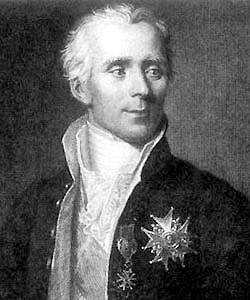FAQ About Pierre-Simon Laplace

Who was Pierre-Simon Laplace?
Pierre-Simon Laplace was a French mathematician and astronomer known for his significant contributions to the fields of probability and celestial mechanics. He lived from 1749 to 1827, and his work laid the foundation for many aspects of modern science.

What is Laplace's most famous work?
Pierre-Simon Laplace is perhaps best known for his work on "Celestial Mechanics." His treatise "Mécanique Céleste," published in five volumes, is considered his magnum opus. It addresses the mathematics and physics governing the motion of celestial bodies and transformed celestial mechanics into a field that could predict complex movements in the solar system.

How did Laplace contribute to probability theory?
Laplace made significant contributions to the establishment of probability theory. His work on probability, particularly "Théorie Analytique des Probabilités," helped formalize the mathematical expressions and analyses of random events and variables. He introduced concepts such as expected value and probability distributions, which are fundamental to the field.

What is the Laplace transform?
The Laplace transform is a mathematical operation named after Pierre-Simon Laplace, which transforms a function of time into a function of complex frequency. It is widely used in engineering, physics, and applied mathematics to simplify differential equations and analyze system behaviors.

Did Laplace have any role in politics or society?
Yes, Laplace held several prominent positions during his lifetime, reflecting his influence beyond academic circles. He served as Minister of the Interior under Napoleon Bonaparte and was made a count of the empire. His presence in politics also coincided with scientific roles, like heading the Bureau des Longitudes.

What is the Laplacian operator?
The Laplacian operator is a differential operator used in mathematics and physics, named after Pierre-Simon Laplace. It is denoted as ∆ or ∇² and is a measure of the rate at which a quantity spreads out from a point. Commonly applied in vector calculus, the Laplacian is essential in electromagnetism and fluid dynamics.

How did Laplace influence modern astronomy?
Laplace's work in celestial mechanics greatly influenced modern astronomy by providing detailed mathematical models of planetary motion and gravitational interactions. He helped to corroborate Newton's law of universal gravitation and developed the nebular hypothesis, which suggested solar system formation from a nebulous cloud of gas and dust.

What was the 'Laplace demon' concept?
The concept of a "Laplace's demon" refers to a thought experiment proposed by Laplace in which, given complete knowledge of the position and velocity of all particles in the universe, an intellect could predict the past and future states of all events. This idea illustrated deterministic philosophy and the predictability of the universe under classical mechanics.

How did Laplace interact with other scientists of his time?
Laplace was well-connected with other leading scientists of his era, collaborating and communicating extensively. He worked alongside figures like Lavoisier in chemistry experiments and engaged with Napoleon and other intellectuals during the French Enlightenment. His influence extended through direct mentorship and intellectual exchange.

What are some major publications by Laplace?
Aside from "Mécanique Céleste" and "Théorie Analytique des Probabilités," Laplace published important papers and books on mathematics, astronomy, and physics. Other notable works include "Exposition du système du monde," which explained the solar system's mechanics in simpler terms for a broader audience.

Was Laplace's work controversial during his time?
Laplace’s work was broadly influential, but not without criticism or debate. For example, his deterministic views raised philosophical questions and discussions among contemporaries, especially regarding free will versus determinism. His absence of mentioning God in scientific explanations postulated a universe governed strictly by physical laws.

Where was Pierre-Simon Laplace born?
Pierre-Simon Laplace was born in the town of Beaumont-en-Auge, in Normandy, France, on March 23, 1749.

What kind of educational background did Laplace have?
Laplace attended the University of Caen and later moved to Paris, where his talents were recognized by influential mathematicians such as Jean le Rond d'Alembert. Despite limited formal education, Laplace's capabilities in mathematics quickly earned him prestigious positions and opportunities to advance his work.

How did Laplace's ideas influence the concept of determinism?
Laplace's formulation of determinism through the hypothetical "Laplace's demon" illustrated a universe fully governed by physical laws, where all events were predetermined by initial conditions. This concept challenged philosophical and scientific thought regarding free will and causality, leaving a profound legacy in both fields.

What is the nebular hypothesis associated with Laplace?
The nebular hypothesis proposed by Laplace suggests that the solar system formed from a rotating cloud of gas and dust. This idea was an important early attempt to explain planetary formation and influenced later developments in astrophysical theories of star and planet formation.

Did Laplace make contributions to mathematics outside probability?
Beyond probability, Laplace contributed significantly to differential equations, celestial mechanics, and other areas of analysis. His work often intersected with applied mathematics, providing tools for solving complex scientific problems and inspiring advancements in fields like thermodynamics and electromagnetism.

How is Laplace's legacy regarded today?
Laplace's legacy is highly esteemed, with his foundational work in probability and celestial mechanics influencing countless fields of study. Many concepts, equations, and principles that he introduced remain integral to physics, mathematics, and engineering, underscoring his enduring impact on science.

What recognition did Laplace receive during his lifetime?
During his lifetime, Laplace garnered considerable recognition, such as appointments to influential scientific positions, membership in academies, and nobility titles. He gained fame for his scientific accomplishments and pivotal roles in institutions managing France's scientific affairs.

Did Laplace work on any experiments or practical projects?
While primarily theoretical, Laplace engaged in experiments, particularly in collaboration with contemporaries like Lavoisier. His explorations in chemistry and physics often intertwined with practical applications, aiming to verify theoretical predictions and contribute to knowledge advancement.

How did Laplace's work influence later scientists?
Laplace’s profound mathematical skills and theoretical insights laid groundwork for later scientists like Henri Poincaré and Albert Einstein. His deterministic philosophy sparked dialogue about physical laws and predictability, influencing scientific paradigms and methodologies in the centuries following his work.
